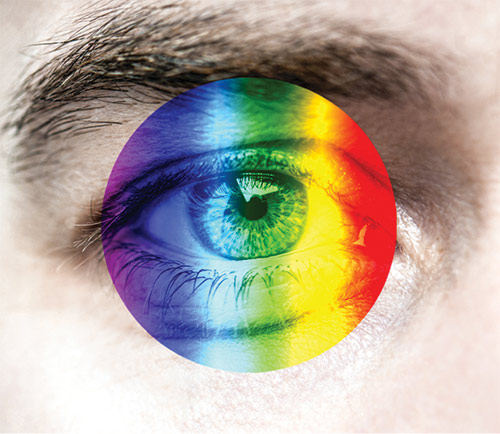
By Linda Conlin, ABOC, NCLEC
“Coach from the eyes down,” is an old saying among coaches, and as eyecare professionals, we know the truth in it. Vision is the primary sense used by athletes and may account for 85 to 90 percent of the sensory processing demands during sports activity. More than speed and strength, vision may be the most important component of sports performance. In studies of mental ability versus physical ability in sports, visual acuity made a bigger difference.In virtually every sport, performance is directly related to how well the player can see. Athlete vision is a set of highly specialized, interrelated skills. The visual system interprets incoming information to tell the athlete where to be and when to get there. The difference a well-made set of sport eyewear can make may be the difference between a ball caught and a game won, and a disappointing walk to the bench.
Lenses must deliver more than acuity; they must provide great depth perception, high contrast sensitivity and vivid color perception. Depth perception enables players to quickly and accurately judge the distance between themselves, the ball, their opponents, teammates, boundary lines and other objects. Contrast sensitivity is the ability to perceive differences between an object and its background. In athletics, the level of contrast sensitivity, as in seeing the size and color of a ball in varying light conditions, can make a split-second difference in hitting, kicking or catching a ball. Color perception is better discrimination of colored surfaces, which results in better reaction time and sharper acuity.
An athlete may have great visual skills but still face visual challenges from the environment. Take blue light, for instance. Blue light focuses slightly in front of the retina causing scatter and visual haze resulting in glare or blur. Glare results in a loss of visual performance because of this retinal defocus. When specific blue wavelengths are blocked, the defocused light is removed for increased clarity and contrast.
Wiley X Captivate sun lenses conquer this and other visual challenges. By filtering out blue light that negatively impacts the eye, while transmitting the longer wavelength beneficial blue light, Captivate removes the haze and allows distant objects to be seen more clearly. By allowing the beneficial blue light to transmit to the eye, Captivate lenses support normal circadian rhythm function. What’s more, by eliminating blue light haze while separating and enhancing colors of the visual spectrum, Captivate lenses enhance depth perception.
Then there’s color perception. Even a healthy human eye has difficulty distinguishing color at the boundaries of the visual spectrum resulting in color confusion at the blue/green and green/red junctures. Organic dyes used in Captivate’s patented color enhancing lens technology attenuate wavelengths associated with color confusion. The brain receives a more precise color signal for enhanced contrast and better color discrimination, providing overall enhancement for all activities, not just sports.
Captivate lenses are polarized as well to attenuate blinding reflected glare, and they protect the eye from UV and HEV light for sun protection. Polarized lenses transmit the vertically oscillating waves of light, which is preferred for clear vision, while eliminating horizontally reflected light. Polarized filters in sunglasses are designed to block horizontally reflected light waves from roads, water and other horizontal surfaces. This reflected light is intensified and results in blinding glare. In other words, reflected horizontally aligned light waves cause overwhelming brightness.
Captivate lenses enhance the view in all environments, providing better contrast, depth perception and color discrimination for all activities. Captivate offers a variety of tint options. Polarized Green Mirror with a copper lens base color offers high performance on slightly cloudy/overcast days and enhances green, orange and blue. Polarized Bronze Mirror with a copper lens base color reduces blue light to allow more saturation of colors in red, yellow and green areas. Polarized Grey with a grey lens base color keeps most colors neutral while enhancing greens. Polarized Blue Mirror with a grey lens base color also keeps most colors neutral while enhancing greens. Polarized Copper with a copper lens base color reduces blue light to allow more saturation of colors in red, yellow and green areas.Polarized Rose Gold with a green lens base color reduces orange and blue peaks to allow greens and yellows to appear more vivid. In short, Captivate lenses are great for all activities in all environments.
It’s up to the eyecare pro to educate the sports enthusiast about quality, safety, durability and craftsmanship in sport eyewear. Wiley X checks all of those boxes with a proprietary oleophobic coating on all Captivate polarized lenses to create a smoother lens surface, which helps to keep dust, dirt, oil, snow and water from sticking to the lens. This, in turn, helps prevent smudging and water spots, making the lenses much easier to clean than an uncoated standard lens, and with premium scratch resistance, Captivate is a lens of the highest quality. Combine those attributes with enhanced color, greater clarity, increased contrast, better depth perception, blocking of UV and only the dangerous blue light wavelengths, and you have a real winner!
For more information on Wiley X Captivate lenses, go to our CE, “Wiley X Lens Technology, Redefining Color with Captivate, in the March issue or at 2020mag.com/ce. The course is free, courtesy of a grant from Wiley X.













